
Hasegawa 1/48 A-4M Skyhawk conversion
|
KIT # |
09399 |
|
PRICE: |
$34.95 |
|
DECALS: |
One aircraft |
|
REVIEWER: |
|
|
NOTES: |
Cutting Edge cockpit, fuselage conversion, and decals, Aires enlarged intakes. |

|
HISTORY |
The last
version of the Douglas Skyhawk carrier-based attack aircraft to be built
for U.S. service, the A-4M saw in front-line service with the U.S.
Marines for 20 years - longer than all other Skyhawks to fly in U.S.
insignia combined. Today, 34 years after the first A-4M came off the
Douglas Palmdale 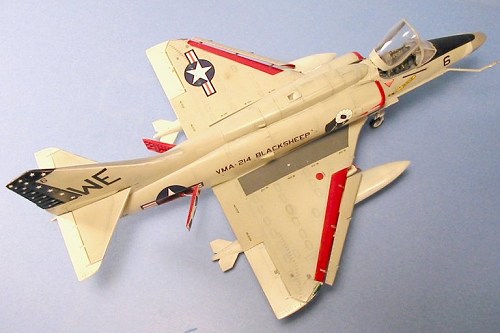 production line on April 10, 1970, and not retired from
the last Marine attack squadron until 1990, A-4Ms still serve in the
Argentine naval air force.
production line on April 10, 1970, and not retired from
the last Marine attack squadron until 1990, A-4Ms still serve in the
Argentine naval air force.
The Skyhawk series was perhaps the most successful single-purpose post-war aircraft of the 20th Century. As a close support light attack aircraft, it had no equal, and was produced in greater quantities than any of its would-be multi-role competitors. The original objective set by the U.S. Navy for Douglas chief designer Ed Heineman was to produce a lightweight, high-performance, carrier-based day attack aircraft capable of dive-bombing, interdiction or close air support, operating against sea or land targets with or without fighter escort in a hostile environment. The resulting A-4 Skyhawk weighed in at 15,000 pounds, half the weight the Navy had expected for a jet-powered replacement for the A-1 Skyraider, capable of carrying a nuclear bomb.
In the mid-Sixties, the Navy looked for a replacement aircraft for the Skyhawk, and ended up accepting the Vought A-7 Corsair II attack bomber. The Marines, however, opted for an updated Skyhawk, which was available for a unit price of $1.5 million in 1969 dollars, much less than the A-7. The A-4M, which first appeared in 1969, was specifically developed to meet USMC requirements in the light of Vietnam combat experience.
Powered by a Pratt & Whitney J52-P-408A rated at 11,200 lbs thrust - 20%
more power than available in the A-4F - and fitted with a smokeless
burner can, the A-4M had a
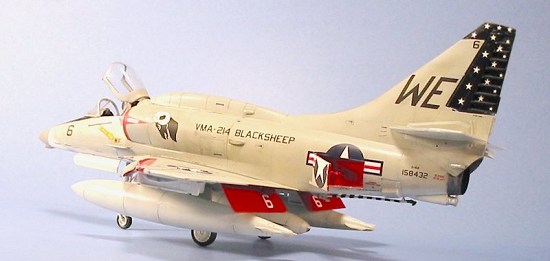 better than 100
percent improvement in maneuverability at Mach 0.75 at sea level (from
1.5 to 3.2G), a 50% improvement in rate of climb (from 5,620fpm to
8,400fpm), a 45-knot increase in maximum speed at sea level, with takeoff
distance reduced from 3.720 feet on a standard day to 2,700 feet.
Internal armament was increased 100 percent to 400rpg, and the tight
cockpit was given an enlarged canopy to improve pilot visibility.
better than 100
percent improvement in maneuverability at Mach 0.75 at sea level (from
1.5 to 3.2G), a 50% improvement in rate of climb (from 5,620fpm to
8,400fpm), a 45-knot increase in maximum speed at sea level, with takeoff
distance reduced from 3.720 feet on a standard day to 2,700 feet.
Internal armament was increased 100 percent to 400rpg, and the tight
cockpit was given an enlarged canopy to improve pilot visibility.
The A-4M entered squadron service on April 16, 1971, when VMA-324 took delivery of four aircraft at MCAS Cherry Point, and the A-4M saw combat in Vietnam in 1972, providing air support against the North Vietnamese Spring Offensive.
|
THE KIT |

For a look at what is in the box, here is a link to the very similar A-4C preview.
It is undoubtedly the case, given Hasegawa's history to date of maximizing the use of molds for multiple-subtype aircraft, that there will be an A-4M released at some future point. However, the latest Hasegawa release list does not show an A-4M, so it will be at least the summer of 2004 at the earliest before such a kit might show up on the market. In the meantime, Cutting Edge has brought out resin conversion parts to turn the A-4F kit into an A-4M. With design guidance by Skyhawk Guru Dave Aungst, the conversion kits are accurate, and easy to use with the basic kit.
|
CONSTRUCTION |

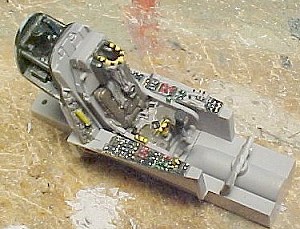 Construction for me started with the necessary modifications to the
fuselage. This involved cutting off the kit part's nose - on a
panel line - and attaching the Cutting Edge resin part. Different
noses are provided, to cater to whether you are building an early, mid,
or late-production A-4M; since I had decals for an early A-4M, I used the
parts for the early-production nose.
Construction for me started with the necessary modifications to the
fuselage. This involved cutting off the kit part's nose - on a
panel line - and attaching the Cutting Edge resin part. Different
noses are provided, to cater to whether you are building an early, mid,
or late-production A-4M; since I had decals for an early A-4M, I used the
parts for the early-production nose.
The resin
cockpit provided by Cutting Edge is a real work of art, with lots of
detail, and a beautifully-cast seat with full seat belts and other
appliances. Completed, this cockpit is vastly superior to what is
provid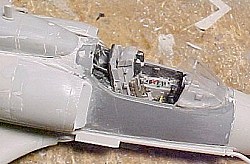 ed in the basic kit. After I had painted and detailed the cockpit,
I installed it in the fuselage, glued in some "cannonball" fish weights
to insure the model would be a nose-sitter, then assembled the fuselage.
I only had to use a little Mr. Surfacer 500 to take care of the
centerline seam and the attachment of the Cutting Edge nose and Aires
enlarged intakes.
ed in the basic kit. After I had painted and detailed the cockpit,
I installed it in the fuselage, glued in some "cannonball" fish weights
to insure the model would be a nose-sitter, then assembled the fuselage.
I only had to use a little Mr. Surfacer 500 to take care of the
centerline seam and the attachment of the Cutting Edge nose and Aires
enlarged intakes.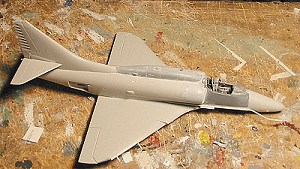
The wing was assembled and test-fitted to the fuselage. Testing for nose-heaviness revealed a need for more weight, which was glued in behind the cockpit and to the rear of the nose wheel well. Satisfied I had a nose-sitter, I glued the wing and fuselage together. With the electronics hump, horizontal stabilizer and braking parachute pack attached, as well as the resin antennas to the trailing edge of the vertical fin, the model was ready for paint.
|
CAMOUFLAGE & MARKINGS |
Painting:
I first painted the inner areas of the wing slats, flaps and dive brakes with Gunze-Sangyo "Shine Red." I then painted the vertical fin with Tamiya X-18 Semi-Gloss Black. When all that was dry I masked these areas off and pre-shaded the rest of the model with Tamiya XF-24 Dark Grey.
The model was painted with Gunze-Sanyo H-316 "White FS17875" for the lower surfaces and H-315 "Grey FS16440" for the upper surfaces. While that was drying, I hand-painted the red borders of the landing gear doors. When all was dry, I gave the model a good coat of Future.
Decals:
The Cutting Edge decals went on easily under a coat of Micro-Sol, with the only "fiddly bit" being the individual application of the stars on the vertical fin.
|
FINAL CONSTRUCTION |
I attached the landing gear, lowered flaps and extended air brakes, and attached the clear resin enlarged canopy in the open position.
|
CONCLUSIONS |
 I really like
Hasegawa's Scooters. If you're one of those people who needs your
instant gratification right now, and can't wait for Hasegawa to get
around to releasing an A-4M, the Cutting Edge conversion parts will allow
you to make any version of the A-4M you want. Unfortunately, I only know
of one decal sheet that covers the A-4M after it went to the all-greys
tactical paint scheme, that being one from SuperScale that has been out
of production for at least ten years I know of. The aftermarket sheet
from Cutting Edge will let you do two grey-and-white early A-4Ms. The
model looks good sitting next to my A-4C and A-4E Skyhawks.
I really like
Hasegawa's Scooters. If you're one of those people who needs your
instant gratification right now, and can't wait for Hasegawa to get
around to releasing an A-4M, the Cutting Edge conversion parts will allow
you to make any version of the A-4M you want. Unfortunately, I only know
of one decal sheet that covers the A-4M after it went to the all-greys
tactical paint scheme, that being one from SuperScale that has been out
of production for at least ten years I know of. The aftermarket sheet
from Cutting Edge will let you do two grey-and-white early A-4Ms. The
model looks good sitting next to my A-4C and A-4E Skyhawks.
August 2003
Thanks to JetSetModels for the kit and Aires intakes, and to Meteor Productions for the A-4M conversion sets and decals.
If you would like your product reviewed fairly and fairly quickly, please contact the editor or see other details in the Note to Contributors.